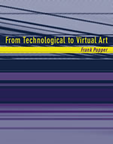January 03, 2007
Frank Popper

From Technological to Virtual Art
From Technological to Virtual Art by Frank Popper: In From Technological to Virtual Art, respected historian of art and technology Frank Popper traces the development of immersive, interactive new media art from its historical antecedents through today's digital, multimedia, and networked art. Popper shows that contemporary virtual art is a further refinement of the technological art of the late twentieth century and also a departure from it. What is new about this new media art, he argues, is its humanization of technology, its emphasis on interactivity, its philosophical investigation of the real and the virtual, and its multisensory nature. He argues further that what distinguishes the artists who practice virtual art from traditional artists is their combined commitment to aesthetics and technology. Their "extra-artistic" goals -- linked to their aesthetic intentions -- concern not only science and society but also basic human needs and drives.
Defining virtual art broadly as art that allows us, through an interface with technology, to immerse ourselves in the image and interact with it, Popper identifies an aesthetic-technological logic of creation that allows artistic expression through integration with technology.
After describing artistic forerunners of virtual art from 1918 to 1983 -- including art that used light, movement, and electronics -- Popper looks at contemporary new media forms and artists. He surveys works that are digital based but materialized, multimedia offline works, interactive digital installations, and multimedia online works (net art) by many artists, among them John Maeda, Jenny Holzer, Brenda Laurel, Agnes Hegedus, Stelarc, and Igor Stromajer. The biographical details included reinforce Popper's idea that technology is humanized by art. Virtual art, he argues, offers a new model for thinking about humanist values in a technological age.
Frank Popper is Professor Emeritus of Aesthetics and the Science of Art at the University of Paris VIII. He is the author of Origins and Development of Kinetic Art, Art, Action, and Participation, Art of the Electronic Age, and other influential works on art and technology.
Table of Contents and Sample Chapters
SERIES FORWARD vii
FOREWARD BY JOEL SLAYTON ix
ACKNOWLEDGMENTS xi
INTRODUCTION
Sample Chapter - Download PDF (64 KB) 1
I. The Emergence of Virtual Art (1918–1983) 9
1. HISTORICAL ANTECEDENTS (1918–1967) 11
Artistic Sources 11
Modern Light Art 13
Spectator Participation 29
Environmental Artistic Commitments 39
Technical Sources (such as Engineering and Inventions) 46
Other Sources (such as Science and Linguistics) 47
2. TECHNOLOGICAL ART AND ARTISTS (1968–1983) 49
Laser Art 49
Holographic Art 52
Eco-technological Art 59
Computer Art 64
Communication Art 75
II. Current Virtual Art and Artists (1983–2004) 87
3. MATERIALIZED DIGITAL-BASED WORK 89
Plastic Issues 89
Cognition Issues 110
Bioaesthetic Issues 118
4. MULTIMEDIA AND MULTISENSORIAL OFF-LINE WORKS 131
Language, Narration, Hypertext 131
Plastic Multimedia Issues 156
Synesthesia 161
Sociopolitical and Security Issues 175
5. INTERACTIVE DIGITAL INSTALLATIONS 181
Sensory Immersion 181
Reciprocal Aesthetic Propositions 220
Individual Commitments to Interactivity 248
Social, Environmental, and Scientific Commitments to Interactivity 275
6. MULTIMEDIA ONLINE WORKS (NET ART) 313
The Internet as a Social Communications Option 313
Personal Presence Online 355
Critical Artistic Attitudes on the Net 371
Telematic and Telerobotic Human Commitments 379
7. CONCLUSION 379
NOTES 399
BIBLIOGRAPHY 405
ARTISTS LIST 415
INDEX
Sample Chapter - Download PDF (135 KB)
Posted by jo at January 3, 2007 10:52 AM
